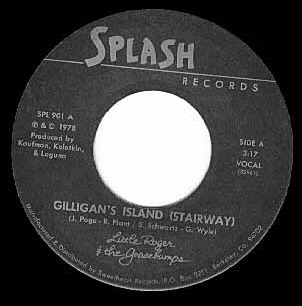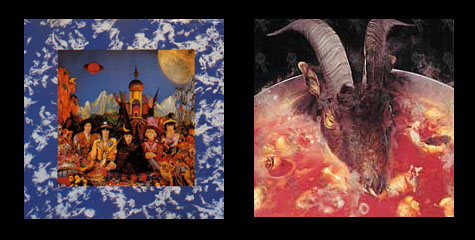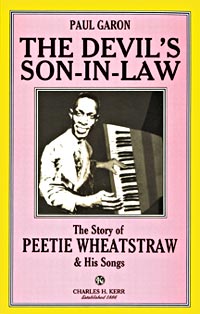|
COVEN was a pop group from Indiana, with some members from Ohio and Great Britain, who released three albums in the late
sixties and early seventies. WITCHCRAFT DESTROYS MINDS AND REAPS SOULS, released by A&M in 1968, was their debut. It has
become a collectors' item based on its rarity (A&M pulled the album after department stores complained about its cover
art and murderous lyric sheet.,) and its groundbreaking, Satanic stance. Here was a group, a whole year before Black Sabbath
and decades ahead of demonic thrash bands like Slayer and Venom, festooning their album cover with depictions of the Satanic
Mass and singing songs about human sacrifice, ritual infanticide and demonic possession. Side one consists of nine short
songs, such as "Black Sabbath," "White Witch of Rose Hall, Coven in Charing,"Pact With Lucifer,"
"Choke, Thirst, Die," and"Dignitaries in Hell." Side two presents a thirteen minute dramatic re-enactment
of a Black Mass.
Coven matched their horror movie lyrics with a horrific, theatrical stageshow. Bathed in red lights, the band would hold elaborate
Black Masses on stage, complete with a crucified actor, in the role of Christ, who would tear himself from the cross, spin
it around upsidedown, and dance about the stage in pagan glee. Anton Levay was so impressed with Coven's live act, he hired
them to headline his "Satanic Woodstock," to be held in Michigan in 1969. The festival was downsized to a short
concert in LA's Whisky A Go Go, where Coven's performance was so intense that Timothy Leary, high on LSD, lept from his seat
and fled the club.
Beneath all the hoopla, however, was a provocatively packaged, psychedelic lite-rock album with little personality or merit
beyond the novelty of its cover and lyrics. Without the Satanic trappings, Coven was merely a wannabe Jefferson Airplane.
Their songs were meandering and hookless. Singer Jinx Dawson, for all her considerable vocal power, sounds silly in her overly-ominous
declamations of demonic mayhem, and the band plods along monotonously throughout.
Mercury's withdrawl of WITCHCRAFT... was a commercial setback from which the band would never recover. Their next album downplayed
the satanic imagery, and died a quick death in the marketplace. Coven did have one hit, a version of "One Tin Soldier,"
which appeared in the 1971 motion picture, "Billy Jack," but the movie was far more popular than the band, and their
success disappered when the film left the theatres. A third album, BLOOD ON THE SNOW, tried to resurrect the Satan gimmick,
but , in the age of Black Sabbath and the heavy metal hordes that followed, Coven's tepid blues rock seemed enemic and their
toned-downed imagery oldhat.
|
|
| Inside Gatefold from WITCHCRAFT... |
BLACK MASS BY LUCIFER: horror-movie synth music from Mort Garson, early seventies synth-lounge pioneer. I bought my copy from
the "Heavy Metal" bin at Electric LadyLand (Louisville, Ky,) when I was eighteen. The first time I played it, an
earthquake shook the New Madrid fault and everyone in my parents' house felt the quake except me.
BLACK MASS 8-track page with MP3.

LITTLE ROGER AND THE GOOSEBUMPS: "Gilligan's Island (Stairway)" In 1978, San Francisco disc jockey Roger Clark
married the lyrics to the Gilligan's Island TV theme with the music of Led Zeppelin's "Stairway to Heaven." A single,
"Gilligan's Island (Stairway)" by Little Roger and the Goosebumps, became a West Coast hit, but was stalled when
Zeppelin manager Peter Grant sued for copyright infringement and the record was withdrawn.
Legend has it that some DJ friends of Roger Clark protested Grant's lawsuit by repeatedly playing tape loops of "Stairway
to Heaven" backwards over the air. Isn't it possible that the persistant rumors that "Stairway to Heaven" contains
prayers to Satan that can only be heard when the record is played backwards originate from this protest? After all, at what
other point in music history would large numbers of people have occasion to play the record backwards enough times to analyze
what the vocals might say reversed?
LED ZEPPELIN IV: This album has become the motherlode for evangelists seeking to prove a connection between rock music and
the occult.
According some listeners, most of whom just happen to be involved in fundamentalist ministries, the song, "Stairway
to Heaven," includes a Satanic message that can only be heard when the record is played backwards. Verdicts differ wildly
as to what the message actually says, but most who claim to hear the message agree that Robert Plant says something about
"my sweet Satan" near the song's mid-way point. A 1982 report to the California State Assembly quoted Plant as saying
"I sing because I live with Satan. The Lord turns me off -- there's no escaping it. Here's to my sweet Satan, whose power
is Satan. He will give you 666. I live for Satan." Another, even weirder, interpretation of the message goes: "oh
here's to my sweet satan, the one who's little path would make me sad, who's power is satan, he'll give you, give you 666,
there was a little toolshed where you made us suffer sad satan."
Why would Led Zeppelin hide a backward prayer to Satan in "Stairway to Heaven?" The answer, for those who actually
hear something besides "woregdeh ruoy ni elssub a s'ereht fi," lies with guitarist Jimmy Page, and his enthusiasm
for Aleister Crowley, the legendary pre-WW2 occultist who called himself "The Great Beast . " Page has been a fan
of Crowley since his days with the Yardbirds. He owns what has been called the world's second largest collection of Crowley's
books. He also has owned Boleskine, Crowley's house on the shores of Loch Ness. His personal symbol (each of the band took
personal symbols, shown on the record label of LED ZEPPELIN IV) is a stylized representation of Crowley's statement, "So
is O," by which the wizard identified himself as the Antichrist (see illustration below.)
In the book, "Magick in Theory and Practice," which Page claims to have read when he was 11, Crowley instructs his
readers on various methods of overcoming conventional thought to allow their minds the free-reign needed for conjuration.
Crowley encourages his acolytes, in a section of the book called, "Liber Taw-Yod-Shin-Aleph-Resh-Bet," to learn
to "think backwards," using backwards speech and media to free the mind. "Let the Exempt Adept...constantly
watch, if convenient, cinematograph films and listen to phonograph records, reversed, and let him so accustom himself to these
they appear natural, and appreciable as a whole," Crowley writes. "Let him practice speaking backwards, thus for
"I am He, let him say, "Eh ma I."
Hear "Starway to Heaven" Backwards (audio file)
"Magick in Theory and Practice" - entire book online
LUCIFER RISING: During the early 70's Jimmy Page's interest in Aleister Crowley led him, inevitably, into the trajectory of
avant garde filmmaker and occultist Kenneth Anger.
At the time, Anger was usually recognized as a former child actor and author of the 1958 book, "Hollywood Babylon."
A small, but growing audience, however, knew him as the auteur behind a series of abstract films of occult significance.
Beginning with "Inauguration of the Pleasure Dome" (1954-56,) Anger began filming carefully choreographed and highly
stylized occult ceremonies in an arresting visual style, which owed much to the grand visions of early Hollywood. "Scorpio
Rising" (1963,) gave these ceremonies pop culture cache by relating them to motorcycle culture and rock 'n' roll. "Invocation
of My Demon Brother" (1969,) documented Satanic cadres within the California hippie scene.

|
| THEIR SATANIC MAJESTIES REQUEST (left,) GOAT'S HEAD SOUP insert (right) |
In 1967, Anger fell in with model and actress Anita Pallenberg, who was dating Brian Jones of the Rolling Stones. Anger was
accepted into the Stones' entourage, and the Stones - particularly Jones and Mick Jagger - became fascinated with their new
friend's liberated attitudes and occult philosophy. Anger's tenure in the Stones' inner circle saw the transformation of the
Stones' public image from that of British R&B bad boys into a more decadent, overtly satanic vibe. The 1967 album, THEIR
SATANIC MAJESTIES REQUEST, is a direct product of Anger's influence. The cover art, for example, is patterned after "Inauguration
of the Pleasure Dome's" technicolor visual style. Although the Stones would soon tire of Anger, their interest in occult
themes and lyrics would continue on through 1968's "Sympathy for the Devil," and 1973's GOAT'S HEAD SOUP, culminating
in TATTOO YOU'S cloven-hoofed innersleeve photo from 1981.
By the time Page met Anger at an auction of Crowley ephemera, the director had been working for several years on a film
he called "Lucifer Rising." Filmed throughout Europe and Egypt, "Lucifer Rising" was a celebration of
the end of the Christian epoch and dawn of a Luciferian Age of Light, as fortold in the writings of Aleister Crowley. Much
of the film had been completed at one time , but most of Anger's footage had been stolen by Anger's live-in boy-toy, musician
Bobby Beausoleil, when Beausoleil joined the Manson Family in 1967.
Anger had re-shot enough footage to complete the film, but was running short on cash and had no editing equipment, or even
a place to work were the equipment made available. Page, intrigued by Anger's reputation and the Crowleyite angle of "Lucifer
Rising," gave Anger free access to his house in London, as well as the basement full of film editing equipment Page
had amassed there.
|
|
| Two Soundtracks for "Lucifer Rising" - Jimmy Page's on left, Bobby Beausoleil's on right |
Anger hired Page to compose and perform a soundtrack for the film. Page initially showed great enthusiasm for the project,
recording several etherial arabesques, built around ambient synthesizer washes and heavily treated guitar synthesizer tracks.
Over time, however, Page's obligations to Led Zeppelin and the cooling of his friendship with Anger put the soundtrack
on indefinite hold. After four years of little or no progress, Anger fired Page in 1976 - the day after Page's girlfriend
had evicted Anger from Page's London house. Page's soundtrack was never released, except as the bootleg shown below. It is
likely, however, that excerpts and ideas from the "Lucifer Rising" score were incorporated into the Led Zeppelin
albums PHYSICAL GRAFFITTI and IN THROUGH THE OUT DOOR.
When "Lucifer Rising" was finally released in 1980, it featured a Wagneresque, guitar-driven soundtrack, written
and performed by Bobby Beausoleil. Beausoleil is serving a life sentence for the 1969 murder of music teacher, Gary Hinman,
and recorded the soundtrack (shown above) from his studio in prison.
Jimmy Page: LUCIFER RISING LP
Bobby Beausoleil: LUCIFER RISING 2xCD
Mick Jagger: INVOCATION OF MY DEMON BROTHER (Soundtrack MP3 - offline until Fall 2005)
The Rolling Stones and Kenneth Anger: "Sex, Magick and Rock 'n' Roll"
|
|
| Aleister Crowley on the cover of SGT PEPPER'S LONELY HEARTS CLUB BAND |

PEETIE WHEATSTRAW (ne William Bunch) was a popular St. Louis blues singer and pianist who recorded at least 160 sides during
the 1930's. He called himself "The Devil's Son-In-Law" and "High Sheriff of Hell," claiming, as did Tommy
Johnson before him, that he had sold his soul to the devil in exchange for musical prowess. Wheatstraw's cool, expressive
style was presumably an influence on fellow dark acolyte Robert Johnson, whose repertoire drew heavily from Peetie's.
The character, "Peetie Wheatstraw," is a figure of Southern folklore who predates Willaim Bunch by several decades.
According to Ralph Ellison, who made reference to the legend in two of his novels, "Invisible Man" and "Juneteenth,"
Peetie Wheatstraw was "the evil half of a twin personality whose challenge was invoked at the start of a pool game. He
was 'the Devil's Son-In-Law,' or 'the High Sheriff of Hell,' in search of his other half, the 'Lord God Stingerroy, ' to shoot
him a game." It's likely that blues singers and bad men had been adopting the name for a very long time when Bunch picked
it up, just as they would continue to use it decades after his death.
On December 21, 1941, Peetie and some friends were driving home from a liquor store, and may have been racing a train
when it struck Wheatstraw's car, killing everyone inside. It was Peetie Wheatstraw's 39th birthday.
THE EXORCIST SOUNDTRACK
Perhaps the most daring soundtrack album ever released by a major label, and one of the most genuinely disturbing horror movie
scores ever produced.
"8 Track Heaven" Review with mp3
"The Sound of Silence" An excellent article on "The Exorcist" with interesting info on the film score, as well as the sound
effects used in the movie.
Wikipedia Entry for Mike Oldfield's TUBULAR BELLS, a passage of which served as the main theme for "The Exorcist"
See also our Modern Composers page (whenever I can around to posting the page) for more information on the main composers
of the soundtrack: George Crumb, Krzysztof Penderecki and Hans Werner Henze
CLICK FOR PAGE 3
|
